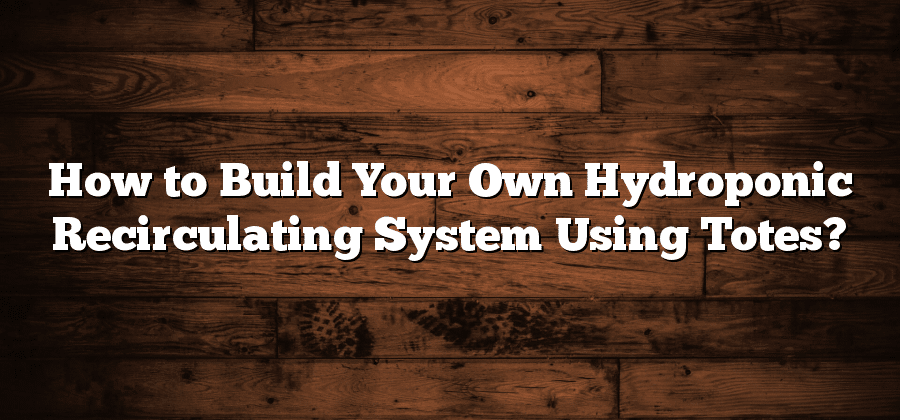Benefits of Hydroponic Recirculating Systems
Hydroponic recirculating systems offer a myriad of benefits for indoor gardening enthusiasts. One of the most significant advantages is the efficient use of water. Unlike traditional soil-based gardening, hydroponic systems recirculate water, allowing growers to reuse and conserve this precious resource. By recirculating water, less water is needed overall, reducing water consumption and lowering utility bills.
Another benefit of hydroponic recirculating systems is the control they provide over nutrient levels. With traditional soil-based gardening, it can be challenging to ensure plants receive the correct balance of nutrients. In hydroponics, growers have complete control over the nutrient solution, allowing them to tailor it to the specific needs of their plants. This precise control results in healthier, more vigorous growth and higher-yielding crops. Additionally, the ability to adjust nutrient levels allows growers to experiment and optimize their plant’s growth, leading to increased overall productivity.
Choosing the Right Totes for Your Hydroponic System
When it comes to setting up a hydroponic system, choosing the right totes is essential. These containers will serve as the growing medium for your plants, so it’s important to select ones that are suitable for hydroponics. The first factor to consider is the material of the tote. Most hydroponic growers opt for food-grade plastic totes, as they are durable, easy to clean, and resistant to corrosion. Additionally, plastic totes are non-reactive, preventing any potentially harmful substances from leaching into the nutrient solution. Another consideration is the size of the tote. It should be large enough to accommodate the root system of your plants, allowing them to grow and expand without restriction. The ideal tote size can vary depending on the type of plants you are growing, but a general rule of thumb is to have at least one square foot of growing space per plant. Furthermore, make sure the totes are lightproof, as exposure to light can promote the growth of algae and hinder the development of your plants. By carefully selecting the right totes for your hydroponic system, you are ensuring optimal conditions for your plants to thrive.
Essential Components for a Hydroponic Recirculating System
Hydroponic recirculating systems are a popular method for growing plants without soil. These systems offer several benefits over traditional soil-based gardening, such as increased water efficiency, faster plant growth, and the ability to grow crops in limited space. To set up a successful hydroponic recirculating system, there are several essential components that you will need to acquire.
First and foremost, you will need a reservoir to hold and circulate the nutrient solution. This reservoir should be made from a food-grade material, such as plastic or stainless steel, to ensure it is safe for your plants. It should also be large enough to hold an adequate amount of solution for your chosen crop. Additionally, the reservoir will need a lid to prevent evaporation and contamination, as well as a drain to facilitate the recirculation of the solution.
Step-by-Step Guide to Assembling Your Hydroponic System
Once you have decided to start your hydroponic system, the first step is to gather all the essential components. The foundation of a successful hydroponic system lies in choosing the right totes or tanks to hold the nutrient solution and support the plants. These totes should be made of food-grade materials and have sturdy construction to prevent any leaks or contamination. Additionally, consider the size and depth of the totes based on the specific plants you plan to grow. Once you have the totes, ensure they are clean and free from any residue or debris before proceeding to the next step.
Next, you will need to assemble the plumbing and irrigation system for your hydroponic setup. This includes connecting the water pump to the tote and creating a closed-loop system that allows for recirculation of the nutrient solution. Depending on the design of your hydroponic system, you may need to install pipes, valves, and fittings to regulate the flow of water and nutrients. It is crucial to ensure that all connections are secure and properly sealed to avoid any leaks. The plumbing system should be designed to provide an adequate supply of water and nutrients to the plants while facilitating efficient recirculation.
Understanding Nutrient Solutions for Hydroponic Systems
Hydroponic systems rely on nutrient solutions to provide the essential elements plants need to grow and thrive. These nutrient solutions are specially formulated to provide a balanced mix of macronutrients, micronutrients, and other beneficial compounds, designed to meet the specific needs of the plants being grown. Understanding the composition and importance of nutrient solutions is crucial for successful hydroponic gardening.
Macronutrients are the primary nutrients required by plants in larger quantities. These include nitrogen, phosphorus, and potassium, also known as NPK. Nitrogen supports foliage growth, phosphorus promotes root development, and potassium aids in overall plant health and resilience. Alongside these macronutrients, hydroponic nutrient solutions also incorporate micronutrients such as iron, manganese, and calcium, which are needed in smaller quantities but are equally important for proper plant development. By carefully balancing these nutrients in the solution and monitoring their levels throughout the growing process, hydroponic gardeners can ensure that their plants receive the proper nourishment required for optimal growth and productivity.
In addition to macronutrients and micronutrients, hydroponic nutrient solutions often contain other beneficial compounds. These include growth enhancers, such as amino acids and vitamins, which can stimulate plant growth and strengthen the plant’s resistance to diseases and pests. pH regulators are also commonly added to nutrient solutions, helping maintain the ideal pH level for nutrient absorption by plant roots. Additionally, some nutrient solutions may include supplements like beneficial bacteria and fungi, which can enhance nutrient uptake and improve the overall plant’s health. Each of these elements plays a vital role in supporting the plants’ growth and maximizing their potential within a hydroponic system.






